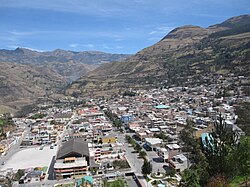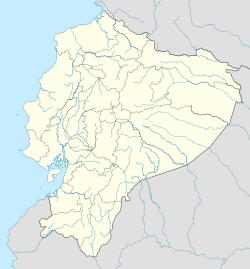Alausí
This article needs additional citations for verification. (September 2019) |
Alausí | |
|---|---|
Town | |
 | |
| Coordinates: 2°11′24″S 78°51′0″W / 2.19000°S 78.85000°W | |
| Country | |
| Province | |
| Canton | Alausí Canton |
| Government | |
| • Mayor | Remigio Roldán Cuzco |
| Area | |
• Town | 1.96 km2 (0.76 sq mi) |
| Population (2022 census)[1] | |
• Town | 6,071 |
| • Density | 3,100/km2 (8,000/sq mi) |
Overview
[edit]
Alausí is a town in the Alausi Canton, located in the Chimborazo province in Ecuador [2].
The town is particularly well-known across Ecuador for its railway heritage. It was named a Pueblo Mágico (magical town) by the Ecuadorian Ministry of Tourism (MINTUR) in 2019.[3]
History
[edit]During the Spanish conquest of Ecuador, the city was named by Sebastián de Belalcázar as San Pedro de Alausí, in honor of the indigenous community the Lausies [4] and giving the city the name of the saint of the day, coinciding with the founding of the city of Quito. Later the founding of the city was legalized by Benálcazar with the name "Alausí". After the creation of the Government of Quito, Alausí formed part of that province as a lesser political and administrative entity.
In 1810, when Quito launched its movement for independence, Alausí recognized the new government and named Captain José Antonio Pontón as its voice and member of the Junta. When the first assembly of the free towns took place in 1811, Captain José Antonio Pontón served as Representative for the Province of Alausí, in which capacity he signed the Carta de Estado de Quito in 1812. In recognition of its patriotism, fidelity, and honor of its inhabitants, the Bishop Cuero y Caicedo resolved that the town's political and administrative status be raised to "Villa".
Transport
[edit]Alausí is served by bus to many destinations in Ecuador. Alausi's bus station is located three blocks down from the train station, on 5 de Junio along the town’s main street. Buses to and from smaller towns run regularly. There are set schedules for more popular destinations, such as Quito, Cuenca and Guayaquil.
Alausí railway station is the starting-off point for the Nariz del Diablo train. This engineering work is among the most audacious projects realized in the Andean mountain range. Nariz del Diablo was the tomb of many Jamaican slaves contracted to dynamite the mountain.[5]
Tourists visiting the Ingapirca ruins in Cañar can board a bus heading for Cuenca. The ruins are about an hour and a half outside of Cañar.
Cityscape
[edit]Alausí is known for its architecture, and most of its houses are more than 100 years old.
In Alausí, one finds various monuments located in the parks and important places in the city. Without doubt the most important is the Monument to Saint Peter (Monumento a San Pedro), the patron saint of the city, built by the Ecuadorian artist Eddie Crespo. This monument is located in the Lluglli Hill (Loma de Lluglli) , and can be seen from any point in the city due to its large size and strategic location.
The most important church in the city is the Iglesia Matriz de Alausi, located in front of the Thirtenth of November Park (parque 13 de Noviembre). The church was constructed in the 18th century with stone extracted from the mines of Chiripungo, located about 2 kilometers outside of the city.
Education
[edit]Overview
[edit]Alausí offers a range of educational institutions serving its urban and rural communities. The region places significant emphasis on improving access to education, particularly in underserved and rural areas, reflecting broader national priorities to foster development and social welfare[6].
- Alausí provides access to both basic and secondary education. The area is characterized by ongoing efforts to increase educational opportunity and quality, especially for economically disadvantaged groups. Challenges include ensuring attendance and overcoming infrastructure deficits common in rural Ecuadorian regions.
- English is taught as a second language in some institutions, with local foundations striving to improve speaking skills to enhance employability and support tourism. Didactic strategies and teacher training are recognized as vital to advancing language instruction and overall educational outcomes [7].
Notable schools
[edit]- Unidad Educativa Ciudad de Alausí
- A prominent school in the city, serving a large student population and providing both basic and secondary education.
- Unidad Educativa Federico González Suárez
- A significant educational institution situated near Iglesia de Alausí, offering a comprehensive curriculum.
- Instituto Tecnológico Superior Manuel Galecio
- This technical institute offers vocational and technical education aimed at equipping students with practical skills.
- Unidad Educativa San Francisco de Sales.
- Unidad Educativa San Vicente Ferrer
Despite persistent barriers—such as limited infrastructure and resources in rural sectors—Alausí continues to invest in education as a means of community and regional development. The integration of language learning, technical training, and targeted support for vulnerable populations underscores the evolving educational landscape in the region.
Festivals
[edit]
Carnaval is the traditional festival of Alausí, and is celebrated with a special parade, in which the neighborhoods of the city and special invitees participate. The most important festival is the running of the bulls where bulls are released through a boarded sstreet until their final destination at the bullfighting ring, similar to a tradition from Pamplona, Spain [8].
A testament to the Spanish influence in South America, the Festival of San Pedro is celebrated from June 22 to July 2, and has been celebrated since the colonial era. Traditional dance, music, folklore, cockfights, bullfights and other activities attract Ecuadorians and international tourists to the celebration.
Notable residents
[edit]- Bolivar Arellano (born 1944) Ecuadorian-American photographer and businessman
See also
[edit]References
[edit]- ^ Citypopulation.de Population and area of Alausí
- ^ Brown, Lawrence A. (2002-09-11). Place, Migration and Development in the Third World: An Alternative Perspective. Routledge. ISBN 978-1-134-93922-0.
- ^ "Patate, Cotacachi y Alausí son los primeros Pueblos Mágicos". El Comercio. Retrieved 2021-04-02.
- ^ Jácome, Julio Castillo (1942). La provincia del Chimborazo en 1.942 (in Spanish). Editores: J. Castillo [y] J. I. Paredes.
- ^ "San Pedro de ALAUSI". www.sanpedrodealausi.com. Archived from the original on 6 May 2003. Retrieved 22 May 2022.
- ^ Fides, Agenzia. "AMERICA/ECUADOR - Improving access to education for children - Agenzia Fides". www.fides.org. Retrieved 2025-07-22.
- ^ Tomalá De La A, Lissette Estephania (2021). "Didactic strategies to improve speaking skills in students from 6 to 7 years old at Alausí Foundation. Alausí, province of Chimborazo, school year 2021 – 2022". rraae.cedia.edu.ec. Retrieved 2025-07-22.
- ^ Yépez Meneses, Carlos David (August 2013). PROYECTO TURÍSTICO SOSTENIBLE PARA LA REVALORIZACIÓN CULTURAL DE LA PARROQUIA RURAL DE SIBAMBE A LO LARGO DE LA RUTA FÉRREA “NARIZ DEL DIABLO”, PROVINCIA DE CHIMBORAZO (Thesis thesis) (in Spanish). UNIBE.

